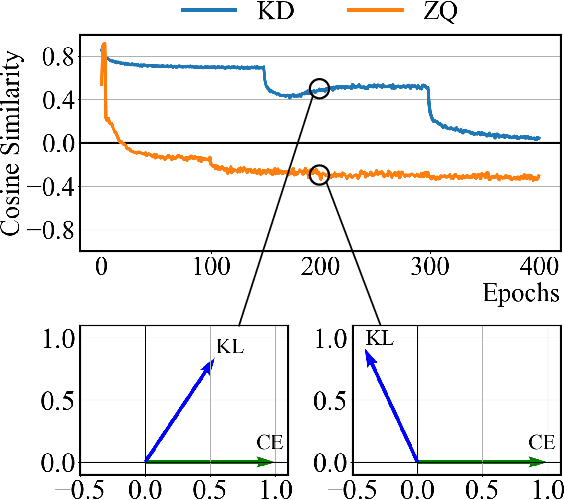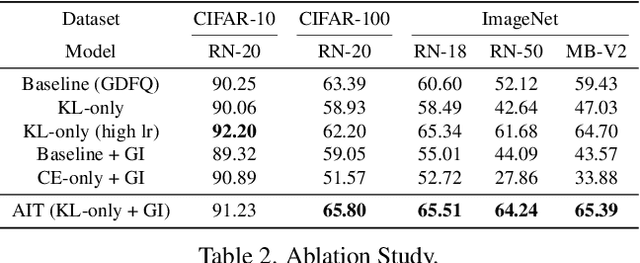Hye Yoon Lee
MimiQ: Low-Bit Data-Free Quantization of Vision Transformers
Jul 29, 2024Abstract:Data-free quantization (DFQ) is a technique that creates a lightweight network from its full-precision counterpart without the original training data, often through a synthetic dataset. Although several DFQ methods have been proposed for vision transformer (ViT) architectures, they fail to achieve efficacy in low-bit settings. Examining the existing methods, we identify that their synthetic data produce misaligned attention maps, while those of the real samples are highly aligned. From the observation of aligned attention, we find that aligning attention maps of synthetic data helps to improve the overall performance of quantized ViTs. Motivated by this finding, we devise \aname, a novel DFQ method designed for ViTs that focuses on inter-head attention similarity. First, we generate synthetic data by aligning head-wise attention responses in relation to spatial query patches. Then, we apply head-wise structural attention distillation to align the attention maps of the quantized network to those of the full-precision teacher. The experimental results show that the proposed method significantly outperforms baselines, setting a new state-of-the-art performance for data-free ViT quantization.
Enabling Hard Constraints in Differentiable Neural Network and Accelerator Co-Exploration
Jan 23, 2023Abstract:Co-exploration of an optimal neural architecture and its hardware accelerator is an approach of rising interest which addresses the computational cost problem, especially in low-profile systems. The large co-exploration space is often handled by adopting the idea of differentiable neural architecture search. However, despite the superior search efficiency of the differentiable co-exploration, it faces a critical challenge of not being able to systematically satisfy hard constraints such as frame rate. To handle the hard constraint problem of differentiable co-exploration, we propose HDX, which searches for hard-constrained solutions without compromising the global design objectives. By manipulating the gradients in the interest of the given hard constraint, high-quality solutions satisfying the constraint can be obtained.
It's All In the Teacher: Zero-Shot Quantization Brought Closer to the Teacher
Apr 01, 2022



Abstract:Model quantization is considered as a promising method to greatly reduce the resource requirements of deep neural networks. To deal with the performance drop induced by quantization errors, a popular method is to use training data to fine-tune quantized networks. In real-world environments, however, such a method is frequently infeasible because training data is unavailable due to security, privacy, or confidentiality concerns. Zero-shot quantization addresses such problems, usually by taking information from the weights of a full-precision teacher network to compensate the performance drop of the quantized networks. In this paper, we first analyze the loss surface of state-of-the-art zero-shot quantization techniques and provide several findings. In contrast to usual knowledge distillation problems, zero-shot quantization often suffers from 1) the difficulty of optimizing multiple loss terms together, and 2) the poor generalization capability due to the use of synthetic samples. Furthermore, we observe that many weights fail to cross the rounding threshold during training the quantized networks even when it is necessary to do so for better performance. Based on the observations, we propose AIT, a simple yet powerful technique for zero-shot quantization, which addresses the aforementioned two problems in the following way: AIT i) uses a KL distance loss only without a cross-entropy loss, and ii) manipulates gradients to guarantee that a certain portion of weights are properly updated after crossing the rounding thresholds. Experiments show that AIT outperforms the performance of many existing methods by a great margin, taking over the overall state-of-the-art position in the field.
 Add to Chrome
Add to Chrome Add to Firefox
Add to Firefox Add to Edge
Add to Edge